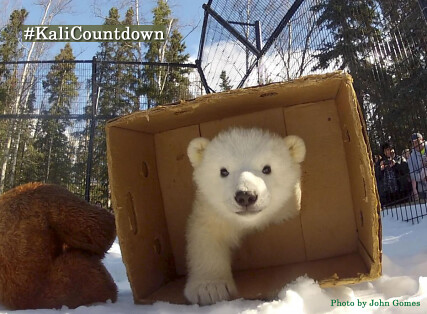The U.S. Fish and Wildlife Service today announced that Kali, the polar bear cub rescued in March from the Point Lay area of Alaska, will leave the Alaska Zoo on May 14, arriving at New York’s Buffalo Zoo on May 15. Kali (pronounced Cully,
the Inupiat name for Point Lay), a 65-pound cub, will join young female cub Luna where both cubs will benefit from each other’s company. Under the care of Alaska Zoo staff Kali has adjusted well to his surroundings, more than tripling in size and weight.
“The Alaska Zoo has done a tremendous job of providing excellent, temporary care for Kali,” said Service Director Dan Ashe. “I would like to personally thank the zoo for stepping up – at moment’s notice – to care for this cub. Now, as Kali leaves Alaska for his next short-term home, we are confident that the Buffalo Zoo will provide the best of care for Kali as the Service makes a final determination on a permanent home for the cub.”
On March 12, the Service received word that a female polar bear had been shot near Point Lay, Alaska. The adult female was accompanied by a cub, which was transferred first to the community of Point Lay, and then to the North Slope Borough’s Department of Wildlife Management in Barrow, Alaska. After the cub was examined and observed to be in good condition, the Service asked the Alaska Zoo to temporarily care for it. Alaska Airlines flew the cub to Anchorage where it was met by Service and Alaska Zoo staff.
“The Alaska Zoo is proud of its long history of partnering with the U.S. Fish & Wildlife Service to provide a home for orphaned and abandoned wildlife,” said Alaska Zoo Director Pat Lampi. “The zoo’s staff has more than 100 years of direct staff experience in raising rescued polar bear cubs.”
Dubbed “Operation Kali,” Kali’s trip from Anchorage to Buffalo has been arranged and funded by M&T Bank, one of the Buffalo Zoo’s long-standing corporate sponsors. Kali will be accompanied by Alaska Zoo Executive Director Patrick Lampi and Zoo Curator Shannon Jensen along with Dr. Kurt Volle, a veterinarian with the Buffalo Zoo. Kali and crew will take off from Anchorage for Buffalo, New York, on a UPS 747- 400 jet on May 14 at 3:09 pm and will arrive in Buffalo on May 15 at 5:16 am after a short layover and plane change at Worldport, UPS’s international air hub in Louisville, Kentucky. On the Louisville to Buffalo leg, Kali will fly aboard a UPS 767, newly fitted with fuel-saving winglets. The 4,400-mile door-to-door time from the Alaska Zoo to the Buffalo Zoo is estimated at 14 hours. Kali’s crate will be the last item loaded on the plane and the first item unloaded. The veterinarian will check on the cub during the flight. Dr. Donna Fernandes, president of the Buffalo Zoo, will greet the Alaskan contingent upon arrival in Buffalo. The cubs will be exhibited together at the zoo once Kali reaches Buffalo.
“We are thrilled to receive Kali,” said Fernandes. “Recovery of orphaned cubs is one of the reasons we are building our new polar bear habitat, Arctic Edge. Both cubs will benefit immensely from the opportunity to play with one another to ensure that they learn to be bears and not become too attached to human caretakers.”
“As the Buffalo Zoo moves forward with its plans for a new world-class polar bear exhibit, we're excited to help bring Kali to Buffalo to join Luna, allowing our neighbors to enjoy learning more about these amazing animals,” said M&T Bank Executive Vice President and Chief Information Officer Michele Trolli.
Kali’s journey from the Arctic coastal plain to the Alaska Zoo to the Buffalo Zoo is the result of collaboration among the people of Point Lay, the North Slope Borough, the North Slope Borough Police Department, the Alaska Zoo, Alaska Airlines, the Buffalo Zoo, M&T Bank, UPS, the Association of Zoos and Aquariums (AZA), the Polar Bear Species Survival Plan® (SSP) management group and the U.S. Fish & Wildlife Service.
The Service will make a final determination on a permanent home for the polar bear cub based on consideration of multiple criteria, including staff experience and expertise, quality of facilities, and the age, sex and temperament of bears currently in the zoo’s collection. Zoos have been an important partner for the conservation of many species, and as climate change continues to threaten polar bear habitat the Service will work closely with the AZA, the Polar Bear SSP and zoos across the country to ensure the proper placement and care of any additional polar bear cubs that may need future care.
For more information about polar bear conservation, visit http://alaska.fws.gov/fisheries/mmm/polarbear/pbmain.htm













